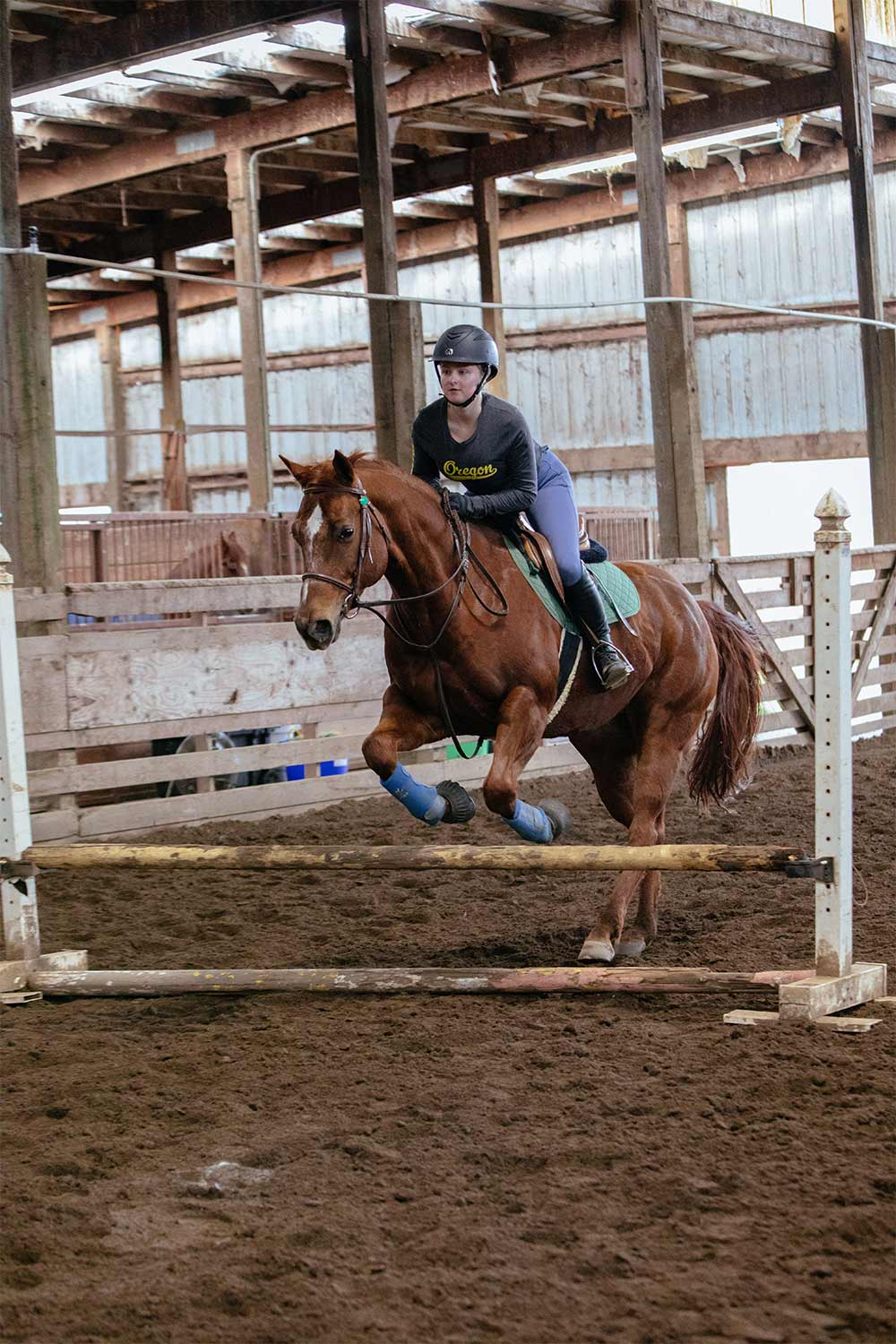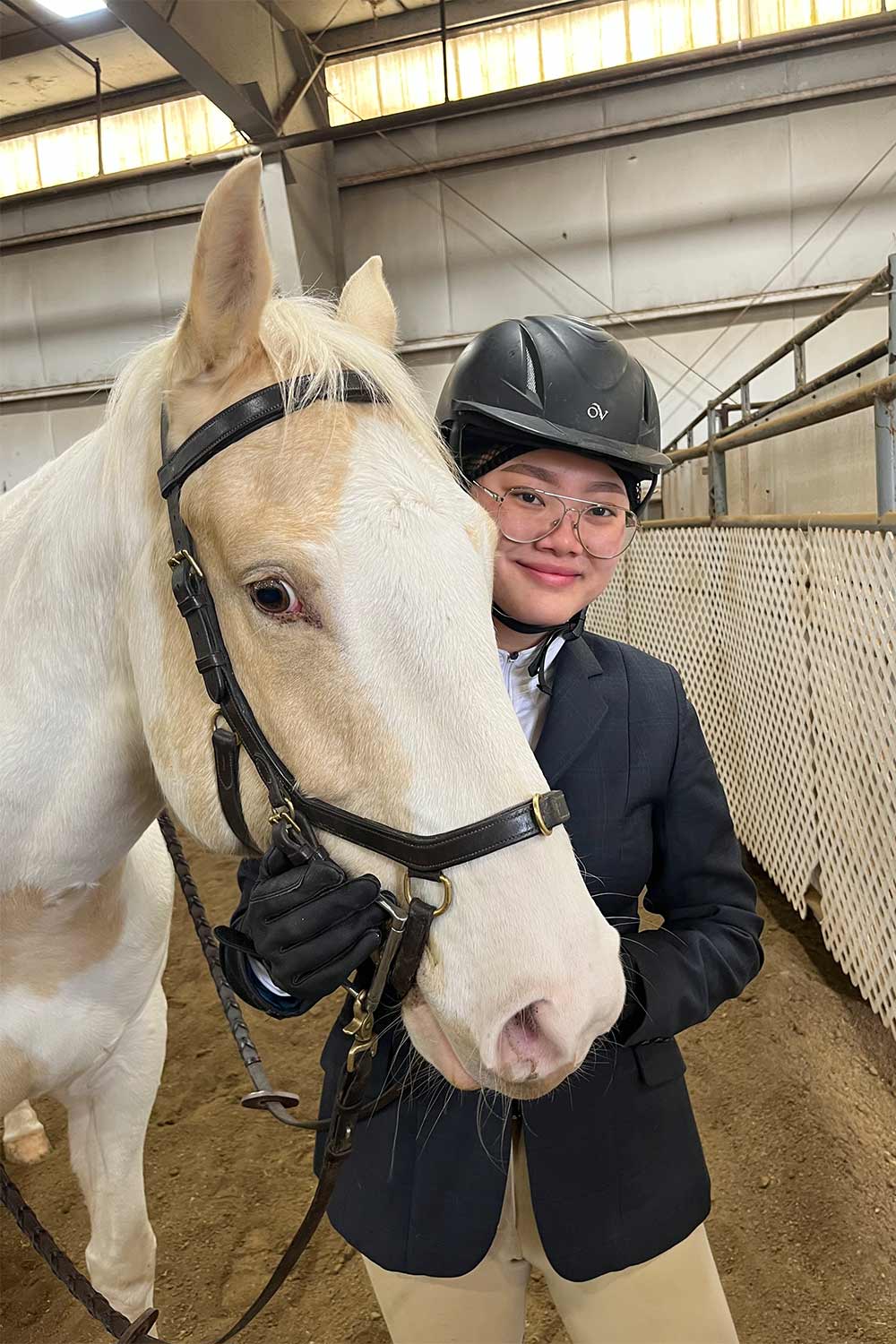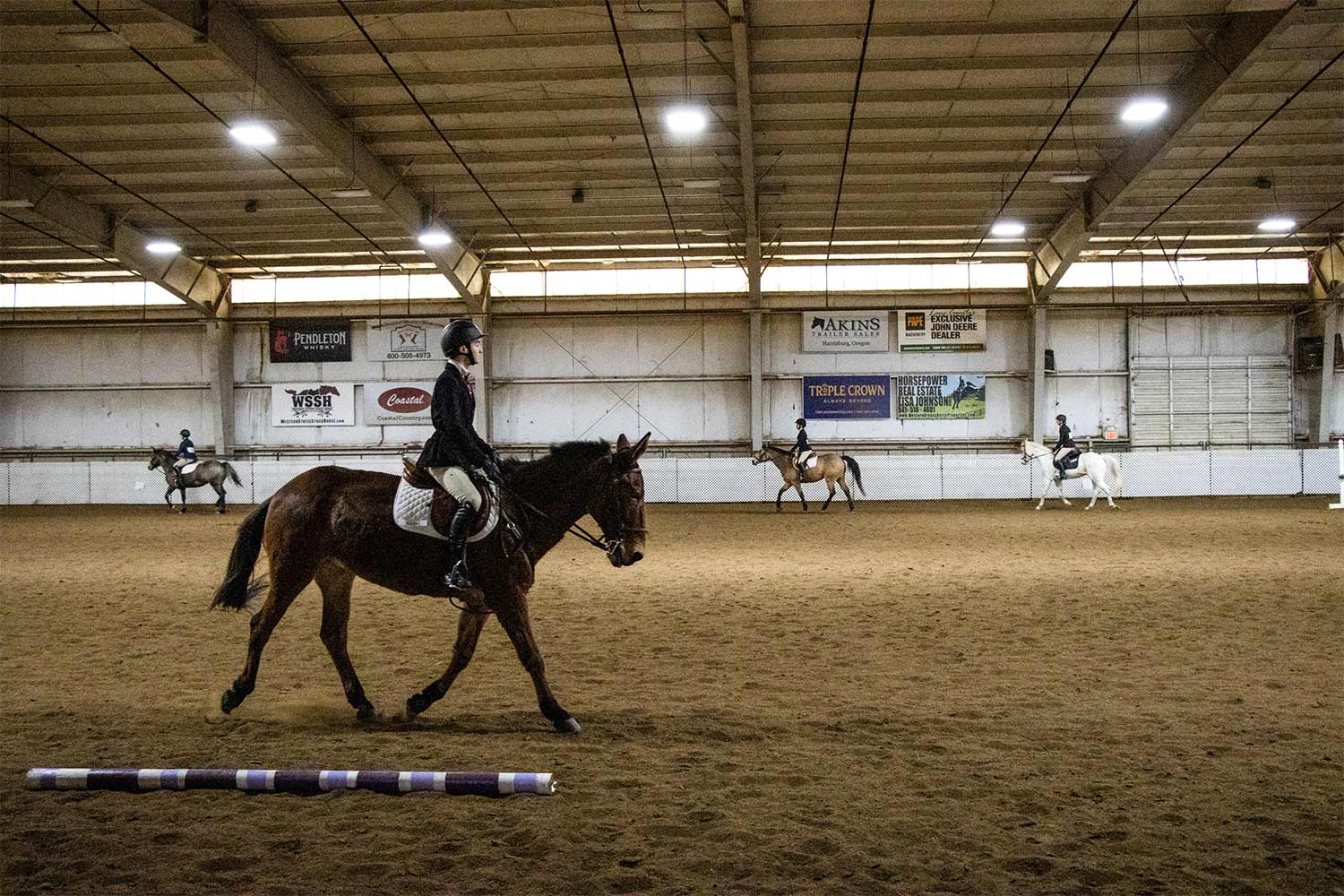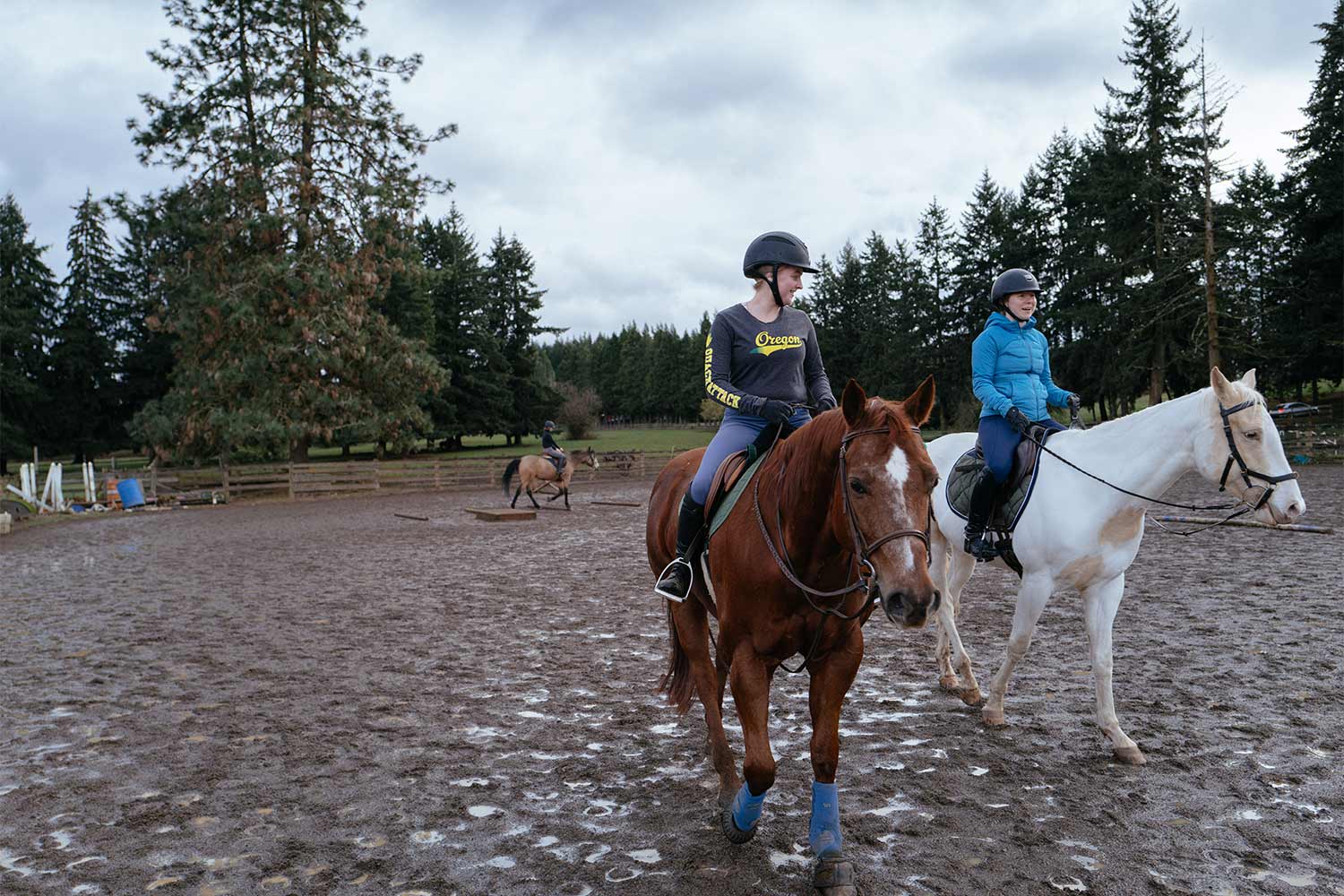Inside the arena at the Oregon Horse Center, the air was bitter cold. However, the atmosphere was filled with excitement. Horses whinnied and snorted as they and their riders prepared to compete. The audience crowded the bleachers and fences to watch their teammates and favorite riders.
The second day of the UO X UBC Triple Hunt Seat Show, hosted by the University of Oregon and the University of British Columbia’s equestrian teams, was about to start at 9 am. The horses and riders rode in a circle around the arena, with the explicit goal of trying to impress the judge with their skills. The horses were asked to walk, trot and canter. When it was all done, the horses and riders would all stand in a line, with the riders’ numbers showing so the judge could see.
Later in the day, horse and rider pairs jumped a course of six fences with the judge noting their skills, form and timing on a horse — or mule — they had often never sat on before.
Enlarge

This Intercollegiate Horse Show Association show was a whole weekend of events Jan. 20-22 at the Horse Center’s Prairie Arena. Equestrian teams from the University of Oregon, University of British Columbia, Western Washington University, Central Washington University, University of Washington and Oregon State University all competed.
Participation in this three-day show is not just about the competition, however. It is also about the bond and community the riders built as a team. Despite certain challenges, ranging from the COVID-19 pandemic to lack of funding, the team continues to thrive, with riders ranging from beginners to those who are quite advanced. This show was focused on Hunt Seat, a form of English riding geared toward jumping fences, but the team is made up of both Hunt Seat and Western riders, and some riders who compete in both.
Morgan Neumann, 20, and Devon Trepess, 23, are co-captains of the Hunt Seat team. They have been riding horses since they were young. Neumann, who placed fourth in the Intermediate Flat twice at the Saturday show and placed second in the Intermediate Flat on Sunday, was introduced to the team through her sister, who was a member.
“I knew before I came to college that I wanted to come here, and then I wanted to be on the riding team here,” Neumann says.
For Trepess, who placed third in the Limit Hunter Seat Equitation Over Fences, being with the club gave new chances to participate in riding.
“I’d never had the opportunity to show because it’s a pretty expensive sport to get into,” Trepess says. “I ended up here because I just really wanted to get that show experience, and it made that possible.”
In addition to veterans such as Trepess and Neumann, there are also a number of newcomers to the team who are leading the next generation of equestrians.
Enlarge

“It’s been so fun,” says Isabella Thibault, 18, who, while a seasoned rider, is in her first year with the club. “Everyone is so nice and supportive, and it’s just a great community to be a part of.” Thibault won her Sunday class riding a mule named Ranger, and finished second on Friday.
That community aspect is one of the defining characteristics of the team. It brings riders together from all walks of life, ranging from riders who are show veterans to those who have never ridden a horse before.
Sebastian Erhan, 18, is also in his first year with the club. Like many of the other riders, he has had experience with horses since an early age. What makes him stand out, however, is that he is the only male rider on the team. For Erhan, though, that has not bothered him at all. “Everyone’s very welcoming,” he says.
Erhan had a successful weekend at the show, competing in the Hunt Seat discipline in the Limit Flat class. He finished 4th on Saturday and 5th on Sunday.
Not all of the riders competing were in advanced categories. There were also some beginners. Just because they were beginners doesn’t mean they couldn’t put on a show, though.
Enlarge

Amy Kelly, 19, is one of those beginners. A first-year rider on the team, she is returning to English riding for the first time in eight years, and due to her lack of experience in that style, she is considered to be in the beginner category.
“I was prepared for it to be super intense and everyone to be really good riders, and for me to be the worst one, but they’re really open to all levels and there’s really no judgment based on your level,” Kelly says. She was also involved with the weekend show and finished triumphantly, riding in the Walk-Trot Beginner Class 1 and finishing first all three times. For two of her winning rides, Kelly rode a paint horse named Noodle, who is white with patches of gold. Noodle’s cheerful demeanor also won him one of the “Best Horse” awards for the show, voted on by all the competitors.
The use of horses like Noodle, who is also one of the UO team’s jumping practice horses, is “donated” for the competition by the horse’s owner. IHSA teams and competitions are designed to be accessible to riders from all walks of life, from beginner to advanced — not just those who own horses. In fact, the riders draw lots for which horse they will ride shortly before they get on it. The only information they have is what the handlers tell them about the horse, and from watching the horse be warmed up.
In addition to the obstacles faced raising money, the COVID-19 pandemic has been difficult on the team. It postponed their riding activities, and between 2021-22 season being their first year back, and since most of the riders that year were seniors and graduated, the number of returning members is quite low this season. Finding a barn with the range and ability of horses to accommodate the riders who need horses to train on has also been an issue.
“Fundraising is always hard to just get people out there raising money,” says Emily Honey, the head coach of the UO Equestrian Team.
Honey, who has led the Western team for five years but also coaches the lower level English riders who aren’t competing at jumping, added that the English show was supposed to be a fundraiser. However, it may not help them much at all.
“I don’t think we’re going to make much money on this show because we didn’t get enough horse donations,” Honey says. “So, when we don’t get enough horse donations, we have to limit how many people enter, and when we limit how many people enter, you limit your income potential.” It is also up to the team members to raise money.
“I’m hoping the team can be a little more proactive because it is a club run sport, so the students are supposed to be doing most of that,” Honey says.
In addition, the team’s status as a club sport affects its opportunities for funding. Other than yearly funding of $5,000 from the university, which according to Trepess is what UO club sports get, they are forced to do a lot of things on their own. The club sports office confirms that each team is responsible for most of their funding. Compare this to the UO women’s soccer team, where the coach alone makes $150,000 as his starting salary, and the UO football team, whose coach made $4.6 million in his first year. Equestrian team members pay their coaches for riding lessons out of their own pockets.
“When it comes to horses, it’s really a lot of money,” Trepess says. “We have to find our own coaches, our own barns, get a lot of the horses ourselves, and so we still are having to ask a lot from our riders in terms of money.” Competition riders pay $400 for the year, and that money goes toward IHSA fees, travel expenses, hotel costs, paying the coaches when they travel, team jackets and other functions.
Camilla Mortensen — who, in addition to her day job as editor of Eugene Weekly, coaches some of the riders who compete in jumping — expressed her frustration that the University of Oregon throws more money at certain sports, like football, than others, including the equestrian team.
“Jumping and riding tends to be female dominated,” Mortensen says. “I think that despite Title IX, UO could be a little bit better about supporting some of the girls’ sports.” Title IX, enacted as part of Education Amendments of 1972, prohibits discrimination on the basis of sex from any educational program receiving from the federal government.
Neumann also wishes the university paid more attention to the team.
“It would just be a lot easier on all of the students,” she says.
Neumann also mentioned that it is tough to find horses in this area for the team to use that can jump, which is an issue because so much of their sport is about that. However, she does not blame the UO for not helping out with that.
“Bringing that idea up to a person who isn’t well-versed in how much horses cost would sound insane,” she says. Based on her experiences buying horses before college, a well-trained jumping horse can cost anywhere between $30,000 and $60,000. Currently, the team members riding with Mortensen are riding far less expensive horses that they have helped train to jump.
Enlarge

Neumann and Trepess both mentioned the struggles the club faces to be recognized. According to Neumann, the equestrian sport at UO is not established as well compared to other areas in the country, including the East Coast, the Midwest and California. She mentioned the University of Southern California, with its wealthy donors and it being a private school, as an example of a more established program.
In spite of these obstacles, the team continues to show strong resilience.
“I’m really proud of the team because a lot of people have really stepped up and been there and putting in the work,” Trepess says.
The hard work has also been noticed by the coaches.
“It can be a very tough sport, and they’re out here doing it without a whole lot of institutional support,” Mortensen says. At the Saturday show, one of the horses spooked at a loudspeaker, jumped sideways and the rider fell. After being checked out by the medic on-site, she got back on another horse and finished the class.
For both the riders and the coaches, there is strong hope for the team’s future, in spite of the obstacles. For the team members, they are just excited about being able to ride again.
As one of the co-captains, Trepess says that her goal is to keep as many people on the team as possible. This will help them get a better shot of making regionals, finals and zones, and they can also travel more. However, they haven’t had as many opportunities to do that this year, because, in the words of Trepess, “90 percent of the team is brand spankin’ new.”
Neumann, the other co-captain, adds that everybody has helped out so much this year, and that has been crucial for their success now and for the rest of the season. It is this camaraderie that has kept the team together this season, through the ups and downs, and bodes well for the team’s future.
“It’s not really about the winning,” Mortensen says.
Make no mistake, though, the UO Equestrian Team has a lot of competitive fire and is aiming to enter more competitions, with Honey mentioning that the English team has the possibility to go to Stanford to compete this year. They will go there if they get the most points of all the teams in their region they compete against, and it is a goal for them. Nonetheless, it is the bonding and sense of the community that makes this team stand out, and may influence other people to join, regardless of their horse riding skills.
Information on the UO Equestrian team and how to make a tax deductible donation can be found at ClubSports.uoregon.edu/equestrian
